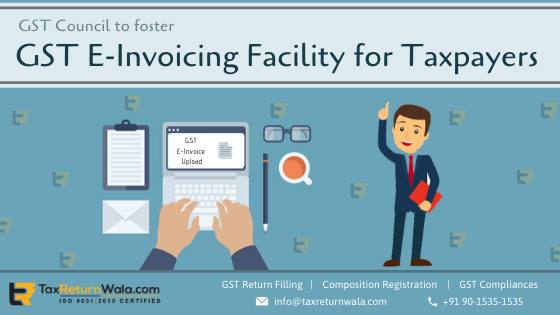Taxpayers to extra care for their tax payments with GST E-invoicing.
GST E-invoicing – Reforms in Goods & Services Tax Act, 2016(“GST”) are progressing in stages and with e-invoicing, the changes are brought to effect digitalization and simplification of the process. Earlier, tax on bills was subjected to State-specific rules and there was no standard format for the invoices. The absence of a standardized invoice performa was found an accompanying reason for tax evasion. Under GST, the requirement for a specified format for tax invoices was firstly recognized by the government.
It was only in the initial year of GST, where the government gave more preference to the changes required in the sector-specific tax rates and GST returns than simplifying basic rules and provisions for a better understanding of GST to the taxpayer.
But as of now, the government has brought in numerous changes in the working ways of the taxpayer where he could easily report his taxes, use an e-way billing system and now use an e-invoicing mechanism to digital generate invoices and automate his tax returns.
GST E-invoicing is an online invoice moderation facility announced by the GST Council’s 37thMeeting on 20th September 2019. In this post, you’ll get to know what additional it brings in the GST system.
About GST E-invoicing
- GST E-invoicing is an online invoice generation cum registration model proposed by the GST council, which comes into effect in the economy from 1st January 2020.
- It will help in digital reporting of business to business (B2B) transactions to the GST system throughout the country.
- Moreover, it is introduced on a voluntary basis.
The model is inclusive of multiple components for e-invoicing including :
- A standardized GST invoice performa which requires the taxpayers to upgrade there individual ERPs(Enterprise Resource Planning) full form please and data fields to match specifications.
- An online portal for registration of invoices where invoices will be digitally registered by the taxpayer and verified by authorities.
Working
Generating E-Invoices :
Step 1: By logging in to the e-invoice portal, the supplier or the taxpayer will have to submit the invoice in a ‘.JSON format (a java file )’.
Note: It will be necessary to upgrade to an ERP which can generate JSON invoices or free utilities available on the GST portal (https://www.gst.gov.in/download/returns )can also be used for the same.
Step 2: On submission of the invoice and signing it digitally, the system will generate a unique reference number (hash number) and a QR code for the same.
Step 3: The IRP (Invoice Registration Portal) will send reports of the uploaded/generated reports of the registered email ids of the supplier and the buyers including details of e-way bills.
ANX-1: Annexure of outward supplies This annexure will contain details of all outward supplies, inward supplies liable to reverse charge and import of goods and services. Details in this annexure will have to be reported invoice-wise (except for B2C supplies) based on a continuous uploading facility to be made available on the GST portal. The reporting can be done on a real-time basis and will be available for the recipient of supplies to take necessary action in their FORM GST ANX-2.
ANX-2: Annexure of inward supplies. GST ANX-2 will contain details of inward supplies auto-populated mainly from the suppliers GST ANX-1. It will also contain details auto-populated from Form GSTR-5 and Form GSTR-6. please elaborate on the use of annexure?
Terms Used:
- ERP: Enterprise resource planning
- IRP: Invoice Registration Portal
- Unique Reference Number: The generation of e-invoice will be the responsibility of the taxpayer who will be required to report the same to Invoice Registration Portal (IRP) of GST. This portal will generate a unique Invoice Reference Number (IRN)
Why E-invoice?
If implemented properly, the introduction of GST E-invoicing mechanism will help the taxpayer in the following manner:
- E-Invoicing will help to reduce the compliance working of the taxpayer.
- It will help to eliminate the use of fake invoices and ensuring the delivery of a standardized digital invoice to the entities.
- It will ensure system-level matching of B2B transactions, ITC(Input tax Credit) and output tax.
- It will ensure better coordination with the banking and other regulatory authorities.
- It will help to automate the filing of tax returns with better accuracy of figures.
Note: The e-invoice will only be considered valid if it is registered and approved on the IRF(Invoice Registration facility).
Things to Remember
The taxpayer shall have to be well prepared before the change to happen with regards to the following :
- An ERP facility/software generating JSON file for invoices is to be used and which can further be calibrated to expected changes in future transactions also (B2C).
- A complete study about 120 fields which have been proposed to be filed before submission of invoices of which 50 are mandatory.
- Pre-planned payment milestones and vendor communications.
References :
- https://www.gstn.org/e-invoice/doc/Final-publishing-e-invoice-with-FAQs-v2.zip
- https://www.gstn.org/e-invoice/doc/eInvoice-Template-for-publication.zip
GST made easy with taxreturnwala.com
Heal your GST compliance burden by emailing us at info@taxreturnwala.com
Also Read: Undervaluation of Goods In Transit, is it the new market trend?


